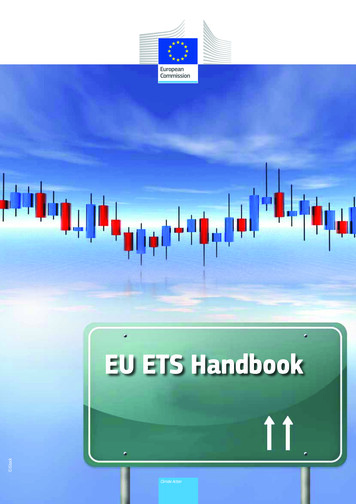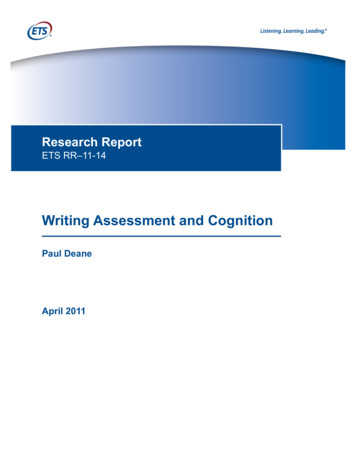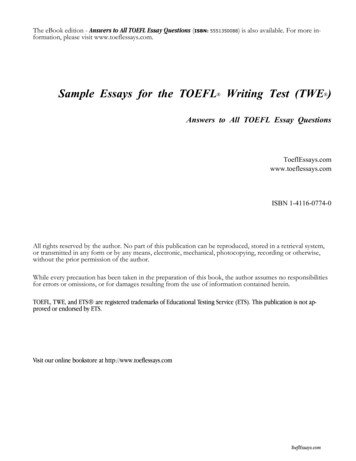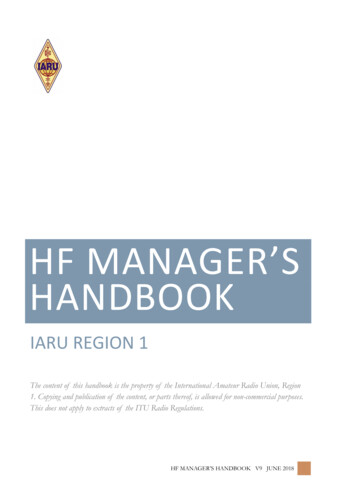
Transcription
iStockEU ETS HandbookClimate Action
ContentsUsing the guide3What is the EU ETS?4Benefits of cap-and-trade5History of the EU ETS7EU legislative structure and the EU ETS9How does the EU ETS contribute to meeting the EU’s climate policy goals?12How does the EU ETS contribute to a competitive economy?14How does the EU ETS work?16Main EU ETS features over the years18Design structure20What GHG emissions does the EU ETS cover?20What is the cap on GHG emissions?22How are allowances allocated?24How allocation has evolved26Auctioning in the EU ETS28Auctioning bodies and venues29Distribution of auctioning rights31Auctioning in practice32Use of auction revenues35Transitional free allocation for modernisation of the power sector (Article 10c)36NER300 fund for demonstration projects38Free allocation in the EU ETS40Timing of determining free allocation41Free allocation shifts compliance costs42From national allocation to EU-wide allocation; NAPs to NIMs43Calculating free allocation using benchmarks44Limit on total free allocation: Correction factors46What is a benchmark?47The process of developing the benchmarks48Product benchmark curves and values49Product benchmark for free allocation51Fall-back approaches for free allocation53Historical Activity Level55Cross-boundary energy - Who should receive free allocation?56Capacity changes/Changes in emissions58When is an installation a new entrant?59Addressing the risk of carbon leakage60Addressing the risk of carbon leakage: Compensation for direct emission costs62Assessing carbon leakage risk: quantitative method63Assessing carbon leakage risk: qualitative method64Addressing the risk of carbon leakage: compensation for indirect emission costs65Carbon Leakage post-202066Carbon leakage: Links to more information67Market oversight69What type of trades can take place?71The Union registry72How does the Union registry work?75The EU Transaction Log771/138
Registry connections78Surrendering, retiring and transferring allowances80Importance of Monitoring, Reporting and Verification (MRV)82Underlying principles of MRV83What do MRV procedures look like?85Monitoring approaches86The “Tier” system of the Monitoring and Reporting Regulation87Aviation89Reforming the EU ETS: structural options92Reforming the EU ETS: Market Stability Reserve95External links: use of international credits96External links to other mechanisms: emissions trading systems98Complying with the EU ETS101The EU ETS Compliance Cycle101Actors in the compliance cycle102What is the correct benchmark for my installation?103Sub-installation boundaries105Are my sub-installations eligible for carbon leakage status?106Attributing GHG emissions to different sub-installations107Cross-boundary heat flow and waste gas allocation108What level of free allocation is my installation entitled to?110How does the Commission assess carbon leakage exposure?111How do operators obtain allowances from auctions?112What are the MRV requirements in the EU ETS?114What are the key changes to the MRV requirements?115MRV: Who has responsibility for what?116What do I need to know about monitoring plans?118How do I report my annual emissions?119What do I need to monitor and report?120What is the verification process?122How can verifiers obtain accreditation?124Must the verifier make site visits?127Timeline for verification128What is the Union registry for?129Opening an account within the Union registry130How do I perform transactions with emission allowances?131Can I bank and borrow allowances?133Penalties for non-compliance134Glossary1352/138
Using the guide This guide provides detailed information about the EU Emissions Trading System (EU ETS),including information about how the system was designed and how it operates. This document is aimed at those who want to understand the EU ETS. Although it has beenwritten for non-experts, this guide does not provide the underlying theory of market-basedinstruments and emissions trading systems in general. Some prior basic knowledge of theprinciples of an emissions trading system would be helpful when using this manual. (see e.g.Hansjèurgens (2010), “Emissions Trading for Climate Policy” or Ellerman et al. (2010),“Pricing Carbon: The European Union Emissions Trading Scheme”). How to use this guide: This guide can be read from start to finish, but can also be used as areference for specific components of the EU ETS. Please refer to the Table of Contents to findthe relevant sections of interest, and then click directly through to that part of the guide.DISCLAIMER: The views expressed in this guide represent those of the authors and are notnecessarily those of the European Commission. This cannot be used as a reference for legalinterpretation of EU legislation on the EU ETS . The legal documents can be found at on thewebsite of DG Climate Action (CLIMA) http://ec.europa.eu/clima/policies/ets/index en.htm : European Union, 2015Reproduction is authorised provided the source is acknowledged3/138
What is the EU ETS?The EU Emissions Trading System (EU ETS) is a ‘cap and trade’ system. It caps the total volume ofGHG emissions from installations and aircraft operators responsible for around 50% of EU GHGemissions. The system allows trading of emission allowances so that the total emissions of theinstallations and aircraft operators stays within the cap and the least-cost measures can be taken upto reduce emissions (see Benefits of cap-and-trade). The EU ETS is a major tool of the EuropeanUnion in its efforts to meet emissions reductions targets now and into the future. The tradingapproach helps to combat climate change in a cost-effective and economically efficient manner. Asthe first and largest emissions trading system for reducing GHG emissions, the EU ETS covers morethan 11,000 power stations and industrial plants in 31 countries, and flights between airports ofparticipating countries.The system was first introduced in 2005, and has undergone several changes since then. Theimplementation of the system has been divided up into distinct trading periods over time, known asphases. The current phase of the EU ETS began in 2013 and will last until 2020.Phase 1(2005-2007)Phase 2(2008-2012)Phase 3(2013-2020)Links: The European Commission’s welcome page on the EU ETShttp://ec.europa.eu/clima/policies/ets/index en.htm EC webpage EU ETS ‘Frequently Asked /faq en.htm European Environment Agency (EEA) 8Phase 4 and beyond(from 2021)
Benefits of cap-and-tradeThe EU chose a “cap-and-trade” structure as the best means of meeting the GHG emissions reductiontarget at least overall cost to participants and the economy as a whole. It allows a set environmentaloutcome to be achieved at lowest costs. A traditional command-and-control approach may mandate astandard limit per installation, but provides little flexibility to companies as to where or howemissions reductions take place. A tax does not guarantee that the GHG emissions reduction targetwill be achieved and in a multi-national system, agreement would be required across all countries onthe right price for carbon. It is also very difficult to determine the “right price” to obtain the cut inemissions required without under- or overcharging companies. Trading allows companies in thesystem to determine what the least-cost option is for them to meet a fixed cap. The carbon price isthen set by the market through trading and based on a wide range of factors.The flexibility of cap-and-trade combined with other key benefits played an important role in thechoice of a cap-and-trade structure: Certainty about quantity: GHG emissions trading directly limits GHG emissions by setting asystem cap that is designed to ensure compliance with the relevant commitment. There iscertainty about the maximum quantity of GHG emissions for the period of time over whichsystem caps are set. This is relevant for supporting the EU’s international objectives andobligations and achieving environmental goals. Cost-effectiveness: Trading reveals the carbon price to meet the desired target. Theflexibility that trading brings means that all firms face the same carbon price and ensuresthat emissions are cut where it costs least to do so. Revenue: If GHG emissions allowances are auctioned, this creates a source of revenue forgovernments, at least 50% of which should be used to fund measures to tackle climatechange in the EU or other Member States, as agreed by Heads of State and government forthe EU ETS directive (see Use of auction revenues). Minimising risk to Member State budgets: The EU ETS provides certainty to emissionsreduction from installations responsible for around 50% of EU emissions. This reduces therisk that Member States will need to purchase additional international units to meet theirinternational commitments under the Kyoto Protocol.Links and references for further information are provided below.Links: EC webpage EU ETS FAQshttp://ec.europa.eu/clima/policies/ets/faq en.htm EC webpage EU ETS ‘Cap’Explanation on what the EU ETS cap is and what it ndex en.htm EC webpage EU ETS Cap FAQQuestions and answers on what a cap is and what it covers in the EU ETS5/138
http://ec.europa.eu/clima/policies/ets/cap/faq en.htm EC webpage Monitoring and reporting of GHG emissionsoThe EU ETS performance on reducing emissions in Member itoring/documentation en.htmoFactsheet “The EU ETS is delivering emission /factsheet ets emissions en.pdfReports on the EU ETS performance by independent organisations, analysts and NGOs Abrell, J., Faye, A. N. and Zachmann, G. (2012), “Assessing the Impact of the EU ETS usingFirm data analysis”, 9.pdf Ellerman, A.D., Convery, F.J. and de Perthuis, C. (2010), “Pricing Carbon: the EuropeanUnion Emissions Trading Scheme”. Environmental Defense Fund (2012), “The EU Emissions Trading System: Results andLessons Learned”, stem-reportLiang et al. (2013), “Assessing the Effectiveness of the EU Emissions Trading issions-trading-system.pdf Martin, R., Muûls, M. and Wagner, U. (2012), “An Evidence Review of the EU EmissionsTrading System, focussing on Effectiveness of the System in driving Industrial /system/uploads/attachment missions-trading-sys.pdf World Bank (2014), “State & Trends of Carbon Pricing 138
History of the EU ETSThe Kyoto Protocol to the UN Framework Convention for Climate Change (UNFCCC) was agreed uponin 1997 and set legally-binding GHG reduction targets, or caps, for 37 industrialised countries for thefirst commitment period (2008–2012). This led to the need for policy instruments to meet the Kyotocommitments. In March 2000 the European Commission presented a green paper on “Greenhousegas emissions trading within the European Union” with some first ideas on the designs of the EU ETS.It served as a basis for numerous stakeholder discussions that helped shaped the EU ETS in the firstphases. This led to the adoption of the EU ETS Directive in 2003 and the introduction of the EU ETS in2005.The first phase of the EU ETS ran from 2005 to 2007 and was seen as the pilot phase. This phase wasused to test price formation in the carbon market and to establish the necessary infrastructure formonitoring, reporting and verification of emissions. The cap was largely based on estimates as therewas no reliable emission data available. The primary purpose of phase 1 was to ensure the EU ETSfunctioned effectively ahead of 2008, to ensure that it would allow the EU Member States to meettheir commitments under the Kyoto Protocol. The so-called Linking Directive 1 allowed businesses touse certain emission reduction units generated under the Kyoto Protocol mechanisms cleandevelopment mechanism (CDM) and joint implementation (JI) to meet their obligations under the EUETS (see External links: Use of international credits). In the first phase businesses were only allowedto use units generated under the CDM for EU ETS compliance.The second phase of the EU ETS ran from 2008 to 2012, the same period as the first commitmentperiod under the Kyoto Protocol. From 2008 businesses could also use emission reduction unitsgenerated under JI to fulfil their obligations under the EU ETS. This made the EU ETS the largestsource of demand for CDM and JI emission reduction units. Towards the end of phase 2 the scope ofthe EU ETS was expanded by including aviation from 2012 (see Aviation).The third phase of the EU ETS was shaped by the lessons learnt from the previous two phases. Inparticular, significant efforts were taken to improve the harmonisation of the scheme across the EUfollowing a review of the EU ETS, agreed upon in 2008. The third phase runs from 2013 to 2020. Thiscoincides with the Kyoto Protocol second commitment period, as agreed in Doha in December 2012.The EU is one of the jurisdictions that has committed to a target under the second commitmentperiod and the EU ETS will be key in achieving the target. Nonetheless, the EU ETS is defined by EUlegislation and operates independently of the actions of other countries or the UNFCCC, underliningthe commitment of the EU to tackle climate change. The EU ETS does not have an end date andcontinues beyond phase 3.1Directive 2004/101/EC of the European Parliament and of the Council amending Directive 2003/87/EC establishing a scheme forgreenhouse gas emission allowance trading within the Community, in respect of the Kyoto Protocol's project mechanisms7/138
Links: United Nations Framework Convention on Climate Change (UNFCCC) webpagehttp://unfccc.int/2860.php Delbeke (2006), EU Environmental Law: The EU Greenhouse Gas Emissions Trading Scheme,Claeys & Casteels EC webpage on the EU ETS 2005–2012A brief summary and description of Phase 1 and dex en.htm The 2004 EU ETS Directive to amend the original EU ETS Directive to allow the use of KyotoProtocol project credits Directive 2004/101/EC The 2008 EU ETS Directive to amend the original EU ETS Directive to include aviation in theEU ETS Directive 2008/101/EC8/138
EU legislative structure and the EU ETSThe EU ETS is an important building block of the EU’s environmental legislation. The Single EuropeanAct (SEA) of 1986, which revised the Treaty of Rome (1957), forms the legal basis for the EU ETS.The SEA added new momentum to European integration and to the completion of the internal marketand expanded the powers of the Community, including on environmental issues, stating that the EUis permitted to put legislation in place "to preserve, protect and improve the quality of theenvironment, to contribute towards protecting human health, and to ensure a prudent and rationalutilization of natural resources".The EU ETS is an environmental law, and therefore falls within European powers and so decisionsabout the EU ETS are made at the European level rather than the Member State (MS) (country) level.The key institutions involved are the European Parliament (the elected representatives of Europeancitizens), the European Commission (Europe’s civil service), and the European Council(representatives of MS governments in European decision-making).The legislative procedure in the EU ETSThe European Commission (referred to as the Commission) is the only institution with the power toinitiate a legislative proposal such as new regulations in the EU ETS or amendments to the EU ETSDirective. The European Council and Parliament can suggest amendments to the legislative proposal,which the Commission can include in an updated legislative proposal. In the end the Council andParliament both need to approve the proposed legislation before it is adopted. Any new legislativeproposals and most amendments to the EU ETS need to follow this co-decision procedure.Although the Parliament, Commission and Council are pivotal to the EU’s legislative processes, theyare supported by other institutions and organisations and several committees within the Parliament,e.g. ENVI and ITRE, 2 and the Commission, e.g. Climate Change Committee. The Commission alsocalls upon external expert groups formed by the Commission to support the preparation of legislativeproposals and implementation of existing EU legislation. Links to the main EU ETS legislation areprovided below.2ENVI is the Environment, Public Health and Food Safety Committee and ITRE is the Industry, Research and Energy Committee. Bothcommittees together with the Climate Change Committee play an important role in the legislative procedure in the EU ETS.9/138
Parliament1st reading(Suggestamendments)2nd reading(accept or suggestnew amendments)Rejectamended textProposalnot adoptedCommissionCouncilLegislative proposal(e.g. new EU ETSregulations oramendments)Proposal amendment(if Parliament suggestsamendments)Communication ofCouncil position amended proposalOpinion on Parliamentamendments amended proposal1st reading(accept or suggestnew amendments)Accept(amended) text2nd reading(accept or rejectnew amendments)Acceptamended textAcceptamended textConciliation CommitteeEqual no. of Parliament and Council members trying to agree on joint text3rd readingvote on joint textProposal not adoptedno agreement on joint text3rd readingvote on joint textLegislative proposal approvedParliament and Council both agree on the same legislative proposal textAdapted from the European Parliament’s website 0081f4b3c7/Law-makingprocedures-in-detail.html) and a figure in Ellerman, Convery & de Perthuis (2010). Pricing Carbon. Cambridge University Press:Cambridge.Implementing EU legislationOnce adopted, legislation must be implemented and the primary responsibility for the implementationof EU law lies with MSs, whilst the Commission has a mandate to enforce proper transposing andimplementation of legislation. For the EU ETS, the Commission has powers of implementation whenuniform conditions of implementation are needed e.g. in determining the allocation of free allowancesand monitoring, reporting and verification of emissions. These rules are implemented on an EU-levelto ensure a harmonised approach between different MSs. The Commission consults MSs prior to theimplementation of implementing measures through the Climate Change Committee in which all MSsare represented. With regards to the EU ETS, around 15 decisions and regulations relating to itsimplementation in areas such as free allocation, monitoring or reporting were examined by ClimateChange Committee.For existing legal acts where the old so-called co-decision procedure was followed, the Parliament andCouncil have a right to veto against a Commission’s proposed measure usually up to three monthsi.e. scrutiny period. This procedure is used, for example, in updating the list of sectors exposed tocarbon leakage risks (see Addressing the risk of carbon leakage). The co-decision procedure nolonger applies for new acts.10/138
Ensuring EU legislation is properly implementedThe Commission is responsible for ensuring that EU legislation is correctly implemented. Should a MSfail to comply with EU law, the Commission may start infringement proceedings. The Commission cantake action and impose sanctions, as set in legislation, against a MS if government legislation is notbeing properly implemented. Ultimately the Commission may refer the case to the European Court ofJustice, which is the legal authority responsible for ensuring that EU law is followed. It also has thepower of judicial review over new legislation to ensure that it is legal under existing EU law. If theCourt finds that an infringement of EU law by the Member State has taken place, it could impose alump sum or penalty payment on the Member State up to the amount specified by the Commission inthe case.Links: The single European Acthttp://europa.eu/legislation summaries/institutional affairs/treaties/treaties singleact en.htm Legislative powers in the EU and description of the ordinary legislative html The Comitology ology/index.cfm?do implementing.home The Treaty on the Functioning of the European Union (Lisbon Treaty)http://eur-lex.europa.eu/resource.html?uri /DOC 1&format PDF The Lisbon Treaty: a comprehensive guidehttp://europa.eu/legislation summaries/institutional affairs/treaties/lisbon treaty/index en.htm Legislation on the implementing powers of the European Commission and Member L/?uri CELEX:32011R0182 EC webpage on the application of EU lawExplanation on the procedure in case of infringement of EU lawhttp://ec.europa.eu/eu law/infringements/infringements en.htm EC webpage on the EU ETSMain EU ETS documentation en.htm11/138
How does the EU ETS contribute to meetingthe EU’s climate policy goals?The EU ETS has been responsible for ensuring industrial and power sites with the largest emissionscontributed to the EU achieving its commitments under the Kyoto Protocol between 2008 and 2012.It continues to do so up to 2020 and beyond.The international community has agreed that global warming should be kept below a 2ºC increase, ascompared to the temperature in pre-industrial times. In 2008, the EU set a series of climate andenergy targets to be met by 2020 in its pathway towards a low-carbon competitive economy, knownas the "20-20-20" targets. These are: A reduction in EU greenhouse gas emissions of at least 20% below 1990 levels 20% of EU energy consumption to come from renewable resources A 20% reduction in primary energy use compared with projected levels, to be achieved byimproving energy efficiency.The 20% reduction in emissions by 1990 requires efforts across all sectors. With this in mind, in 2008the EU decided to extend the EU ETS from 2013 to cover more sectors and gases and set anemissions cap at EU level, which requires a reduction of -21% compared to 2005 by sectors coveredby the EU ETS. It also established the Effort Sharing Decision, which requires a reduction by non-ETSsectors of -10% compared to 2005 that is then shared out between Member States. The 20-20-20targets were established using economic modelling to imply least costs for the EU economy as awhole in moving towards a low-carbon economy.12/138
EU post-2020 climate policy goalsEU leaders have also agreed to the objective of reducing GHG emissions by 80-95% by 2050compared to 1990 levels, in order to keep climate change below 2 C. With that objective in mind,the Commission has produced a roadmap for moving to a low carbon economy by 2050. An importantmilestone in the decarbonisation pathway towards 2050 is the 2030 framework for climate andenergy policies proposed on January 2014 and agreed upon by EU leaders in October 2014, whichforesees: A reduction of GHG emissions by 40% below the 1990 level by 2030 to be achieveddomestically; An increase of the EU-wide renewable energy share to at least 27%; and Improving energy efficiency by at least 27% by 2030, with 30% by 2030 in mindThe EU ETS will play a key role in promoting decarbonisation in sectors such as the power sector.The EU ETS has a default emission reduction of 1.74% per year that applies beyond 2020, with areview set to take place before 2025. The overall GHG emission reduction target of 40% outlined inthe proposed 2030 framework implies an overall reduction of EU ETS emissions by 43% relative to2005, equivalent to a linear emission reduction in of 2.2% per year beyond 2020. The cap wouldneed to be met through domestic emissions reductions within the EU. This will allow the EU ETS tocontinue its significant contribution in moving to a low carbon economy by 2050 (see How does theEU ETS contribute to a competitive economy?).Links: EC webpage on the EU 2020 Climate and Energy PackageA brief summary and description of the EU 2020 climate and energy index en.htm EC webpage EU Climate and Energy Package FAQsQuestions and answers about the progress of the 20% target and moving to a 30% aq en.htm EC webpage on the EU 2030 framework for climate and energy policiesA brief summary and description of the EU climate and energy targets under the 2030framework http://ec.europa.eu/clima/policies/2030/index en.htm European Council conclusions of 23/24 October 2014European Council conclusions on the 2030 climate and energy policy frameworkhttp://www.consilium.europa.eu/uedocs/cms data/docs/pressdata/en/ec/145397.pdf EC webpage on the 2015 international climate change agreementA brief summary on the progress of the 2015 international climate change ational/negotiations/future/index en.htm EC webpage on the EU 2050 low-carbon roadmapDescription of the roadmap for moving to a low-carbon economy in ex en.htm13/138
How does the EU ETS contribute to acompetitive economy?EU leaders envisage that the European economy can cut most of its GHG emissions by 2050 throughsmart, sustainable and inclusive growth. The Commission’s roadmap for moving to a low-carboneconomy by 2050 includes a key role for the EU ETS in promoting decarbonisation throughout theEuropean economy.The EU ETS contributes to the creation of jobs, generation of green growth and strengthening longterm competitiveness of the European economy by putting a price on carbon. Specifically: It stimulates investments in energy efficiency measures, reducing energy costs and financialrisks associated with increasing energy prices It offers an incentive to invest in renewable energy technology, reducing the energydependency on fossil fuel imports and enhancing energy security It strengthens the EU ambition to decarbonise the European economy, providing a long-termstable policy environment for low carbon investments and clean technology.The EU ETS also provides financial support for innovative renewable energy technology and carboncapture and storage projects through the NER300 fund (See NER300 fund for demonstrationprojects). Revenues generated from the EU ETS also provide Member States with funding that can beused for low carbon and renewable energy programmes.On the other hand, the price on carbon raises costs associated with pollution, and there are concernsthat there could be an impact on the competitiveness of certain industrial sectors relative tocompetitors in countries where there are lower levels of action to reduce GHG pollution. In order toaddress these concerns, industry sectors at risk of carbon leakage due to carbon price under the EUETS are supported through the provision of additional free emission allowances as well as by state aidby Member States (see Addressing the risk of carbon leakage).The EU ETS supports the decoupling of energy consumption and GHG emissions from economicgrowth. To support the promotion of low-carbon investment at least-cost to society, the Commissionhas made proposals, based on lessons learnt, to improve the effectiveness of EU ETS (see Reformingthe EU ETS: structural options).Links: EC webpage on the EU 2020 Climate and Energy PackageDescription of the EU ETS together with other climate change mitigation instruments in theEU Climate and Energy index en.htm EC webpage on the European SemesterDescription of the progress towards 2020 ogress/index en.htm14/138
EC webpage on the EU 2050 low-carbon roadmapDescription of the roadmap for moving to a low-carbon economy in ex en.htm15/138
How does the EU ETS work?The EU ETS is a ‘cap and trade’ system, which works by capping overall GHG emissions of allparticipants in the system. The EU ETS legislation creates allowances which are essentially rights toemit GHG emissions equivalent to the global warming potential of 1 tonne of CO₂ equivalent (tCO2e).The level of the cap determines the number of allowances available in the whole system. The cap isdesigned to decrease annually from 2013, reducing the number of allowances available to businessescovered by the EU ETS by 1.74% per year. This allows companies to slowly adjust to meeting theincreasingly ambitious overall target for emissions reductions.Each year, a proportion of the allowances are given to certain participants for free (for example insectors where there is considered to be a potential risk, if they pay the full cost of all the pollutionallowances they need, that production (and pollution) could shift to countries with less ambitiousemissions reduction action – see Addressing the risk of carbon leakage), while the rest are sold,mostly through auctions. At the end of a year the participants must return an allowance for everytonne of CO2e they emit during that year. If a participant has insufficient allowances then it musteither take measures to reduce its emissions or buy more allowances on the market. Participants canacquire allowances at auction, or from each other.In this example, Factory B does not have enough free allowances to cover its emissions, so it caneither comply with the cap by buying allowances from
Climate Action iStock EU ETS Handbook. 1/138 Contents Using the guide 3 . Trading reveals the carbon price to meet the desired target. The . eu-emissions-trading-system.pdf Martin, R., Muûls, M. and W










